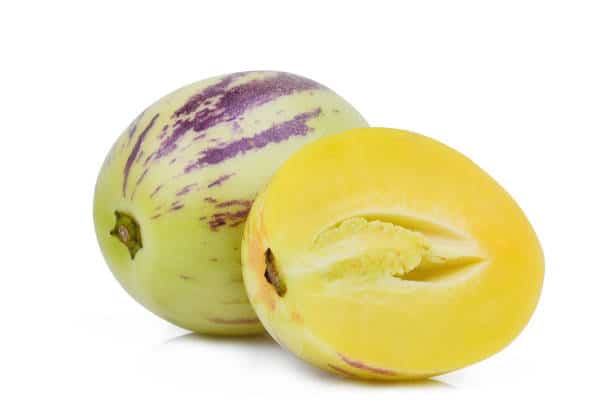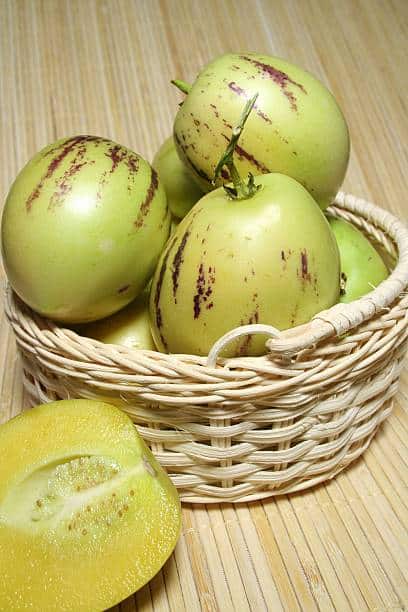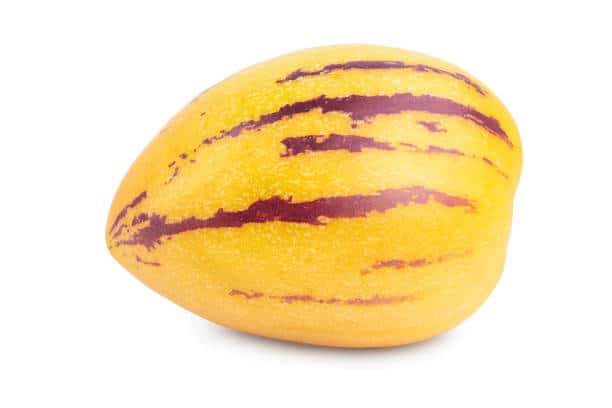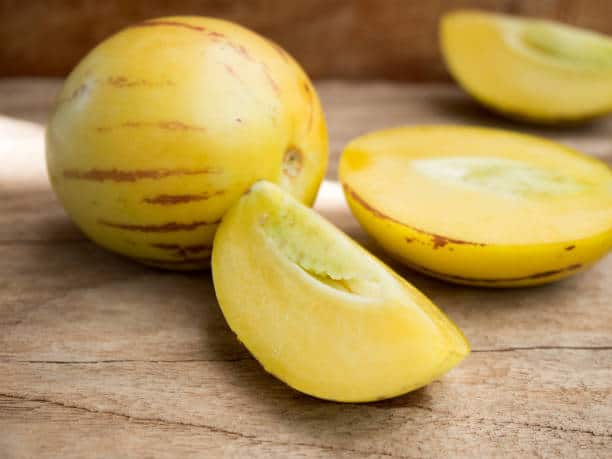
What Is a Pepino Melon?
Pepino melons are growing wild in Ecuador. They have a strong cucumber taste and come in either green or orange-yellow flesh. The bright yellow seeds (or pips) inside Pepinos look like little pumpkins, hence the name “melon gourd.”
Where Does Pepino Originate?
Pepino is a popular nightshade fruit that originated in South America. The Pepino melon is believed to have been introduced to Europe by Spanish explorers in the 16th century, and it is now grown in many countries around the world.
Pepinos are typically oval or oblong in shape and have thin, green skin.
The flesh of the Pepino is white or pale green and is filled with small, black seeds. Pepinos have a sweet, cucumber-like flavor and are often used in salads, salsas, and other dishes.
Pepino Melon Care & Maintenance:
Pepinos are easy to grow in containers and are perfect for balcony gardens. Most gardeners who have grown Pepino melons report that they bear fruit fairly quickly, sometimes growing 8″ long and weighing up to a pound. Pepinos can be eaten raw like cucumbers or cooked in soups, stews, salads, and stir-frys. They shouldn’t be eaten uncooked due to the potential of them being toxic (more on this later).
Most people recommend picking the Pepino when it’s about 6 inches long so that you get both green and orange fleshy parts; however, I’ve left mine on the vine well into summer because I enjoy looking at its lily-like leaves. This is fine as long as the plant has plenty of water and is in a location that receives plenty of sun.
Pepino melons grow on small, bushy plants that are slow-growing. When grown indoors the plant can be placed inside a large container or used as a tabletop display. They will need to be watered regularly because they are sensitive to drought conditions. Pepinos like their roots to remain moist so it’s possible for them to rot if left out in very rainy conditions (which is what happened with my first crop!).
If you want more than one Pepino, putting several cuttings in planters should produce a few extra fruit-bearing plants.
Where To Buy:

Pepino Melon Light Requirements:

Pepinos need strong sunlight to grow so they should be placed in a warm, sunny window or outside. Your plant will not bloom if it doesn’t receive enough light. If your plant is receiving too much direct sun exposure (especially from the hot summer sun), leaves may turn brown and fall off.
If you have a small apartment and can’t use an indoor artificial light source (such as fluorescent lamps) because the plants are sensitive to heat then think about using an indoor reflector like this one:

Makes sure that the unit has 3 sides that absorb and reflect light back onto the Pepino seedlings. These plants require more light than most vegetables so don’t expect them to grow well under regular household lighting.
Watering Requirements & Watering Problems:
Pepinos need a lot of water! The soil should always be moist but not wet or saturated so make sure that drainage is good and the pot has holes at the bottom so that excess water can flow out. If the plant isn’t getting enough water it will appear more wilted as time progresses and when it’s completely dry the leaves will fall off. You can also tell if your plant needs more water by checking to see if the skin is wrinkled or begins to turn brown in any spots (the damage extends down into the fruit).
Watering Problems: Pepino plants don’t like wet, soggy soil so make sure that your pot has drainage holes at the bottom and place it in a tray that catches excess water. If there aren’t enough drainage holes then add small stones to help with drainage. Too much watering in pots may saturate the roots which will cause them to rot. Leave out a small saucer under your planter too because dampness can accumulate around their base (only leave this out for one day).
Be careful about over-watering, if your plant’s soil is constantly wet then it will rot the root system and kill your Pepino.
Feeding Requirements & Fertilization Problems:

Pepinos need to be fertilized regularly in order to produce good quality fruit (it will grow them faster too). If your plant isn’t producing bountiful melons then check further down for some common problems that may be affecting their growth.
Fertilizer Problems: Your plant won’t have any nutrients to draw from if it doesn’t receive enough fertilizer. A standard houseplant fertilizer with an N-P-K ratio of 5-10-5 can be added once a week during the summer months. Read the ingredients list first; you want a fertilizer that doesn’t have any added salts or sugars (which could cause your plant to rot). If you’re unsure about the ingredients then ask someone at your gardening store.
Image Source
Severe Fertilizer Problem: If too much fertilizer is added, it may produce side effects like brown spots on leaves, wilting of the lower leaves, yellowing of the leaf margins, and rotting of the roots. Too much fertilizer can also cause fruit to taste bitter and small in size (the tops will be larger than the bottoms).
Similar Fruit Problems: Overwatering is another common problem for Pepino plants; if there aren’t enough drainage holes in your pot then water may build up around its base and start to rot the roots.
If you use a saucer under your potted Pepino, make sure there are no cracks or holes in it because this is where water can collect (your plant needs good drainage). A healthy plant should have dark green leaves and lots of new growth but if its leaves begin to yellow then something may be wrong.
Throw out any fruit that starts to rot; if any of your fruits become mushy with brown spots on them throw those away as well because they probably have an infection.
How To Prevent Your Plant From Getting Sick:

Always wash your hands before handling the Pepino plants (this will help prevent bacteria from spreading) and keep all tools clean by washing them off too. Your plants should be kept away from any chemicals and fertilizers that may cause them harm.
Check the leaves on a regular basis; look for brown spots or wilting (the plant could also be infested with insects like aphids). How To Tell If There Is A Problem: Look at the bottom of your Pepino’s leaves to see if they’re turning brown.
Pull apart 2-3 leaves to inspect the underside of one; it should appear light green, not yellow or brown. Check out each fruit too; if there are any mushy parts then throw those away! The skin should have some give to it, don’t buy melons that feel very hard when you press on them.
Avoid buying sick plants because you won’t know how they are until you take them home. Buy plants that look healthy and have lots of new leaves growing out of them. Also, remember to wash your hands before handling the roots or seeds in order to minimize the spread of germs.
Soil Requirements:
Pepinos don’t require rich soil so you can use the regular potting mix to grow them. However, the soil must be well-draining; if it’s over-watered then it may rot the root system and kill your plant.
Keep an eye on the soil too, you want it to remain moist but not wet (a good way to check is by sticking your finger about 4 inches into the dirt). If your plant’s soil is dry for several weeks then its roots will die and decay, which will cause all of its leaves to wither away as well.
When To Harvest Pepino Melon:

You can harvest the fruit once it reaches a diameter of 3.5 inches in length; you don’t want to wait until they’re too big because the taste will become bland, and they won’t be sweet anymore either.
How Do You Eat A Pepino Melon?
Pepino melons are a type of fruit that looks like a cross between a cucumber and a melon. They have a smooth, green exterior and white flesh that is speckled with black seeds.
Pepino melons are native to South America, but they can now be found in grocery stores across the United States. When choosing a Pepino melon, look for one that is heavy for its size and has a dull finish. The skin should also be free of blemishes.
To eat a Pepino melon, simply cut it in half and scoop out the seeds. The flesh can be eaten raw or used in salads, smoothies, or cocktails. Pepino melons are refreshing and have a sweetness that is similar to honeydew melons.
How To Store Pepino Melon:
You should refrigerate your melons once they’ve ripened but keep them no longer than one or two weeks before eating them.
Always wrap your fruits in plastic so they stay fresh! Make sure there is good air circulation around the containers (if there isn’t then place some paper towels inside to help circulate the air).
If you need to store it for longer periods of time than that, cut off each end and separately wrap each with plastic (this will prevent the inside from getting rotten).
Once cut, you can keep your Pepino in a plastic container for up to two days.
Types Of Pest:
Aphids will sometimes attack the fruit and eat it. Prevention: Spray your plants with water or use insecticidal soap to kill aphids before they begin infesting your other fruits.
All About Pepino Melon Seeds: You can grow more plants by saving the seeds from a ripe fruit but you must separate them from their flesh first (otherwise, they’ll get moldy).
First of all, spit out any seeds that have gone bad; then take each one inside to clean off its flesh. The best way to do this is by rubbing your finger along its length (don’t put it under running water because this could cause it to sprout prematurely). Now just place the seeds into a container filled with moist potting soil and
Conclusion
It is important to take care of your plant’s health in order for it to produce delicious fruit. You can prevent sickness by washing your hands and not touching the roots or seeds, as well as keeping all tools clean.
It is also important that you buy plants from reputable vendors who have healthy-looking leaves growing out of them.
You should check on the soil daily because if it becomes too wet then it may rot the root system and kill off your plant entirely!
Once you are ready to harvest, make sure they reach 3 ½ inches before harvesting so they don’t become bland tasting or lose their sweetness along with other qualities like crispness or juiciness. Lastly, when storing Pepino melons always keep them refrigerated no










